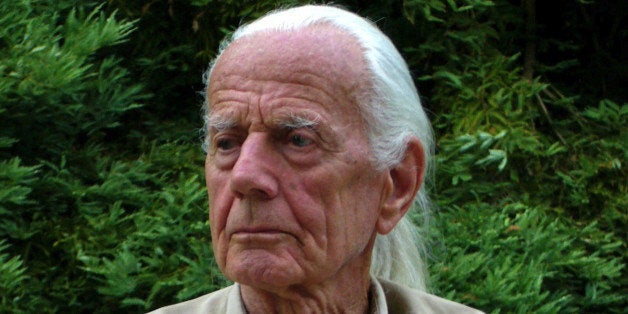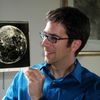
Eccentric telescope pioneer and world-renowned astronomer John Dobson passed away this month at the age of 98. He revolutionized astronomy with a homemade telescope design now belovedly known as the Dobsonian Telescope and made the sky more accessible to the backyard star gazer. He founded Sidewalk Astronomers and brought telescopes to a street corner near you. His motto: "Have telescope. Will travel."
The Dobsonian Telescope
Dobson spent most of his life in the San Francisco area. After graduating from UC Berkeley with a chemistry degree, he dabbled in many fields, including modern dance. As a member of the Carol Beals dance group, Dobson participated in politically motivated dramatizations. In 1934 he performed for the Waterfront strike that began after two workers were killed on the job. "I was all muscles back then," he said. "I had this long hair, and, well, you might understand that I would look a little funny to the dock workers."
Dobson spent the next 23 years of his life as a monk in San Francisco's Vedanta Monastery, where he had his astronomical awakening. In his free time he made his own telescopes out of scrap parts and donated materials. As a monk he was allowed no personal possessions and had to hide his activities. He ground his mirrors for hours in a tub of water so that the scraping sound would not alert the other monks.
At night he would sneak out to the streets of San Francisco to try his telescopes. He quickly became hooked on these nocturnal pursuits, where he shared views of the heavens with an enthusiastic public.
When the other monks found out, they threw him out of the monastery and threw his telescope into San Francisco Bay. They never believed his astronomical excuse and reasoned that he must be doing sinful things under the cover of darkness.
His dismissal from the monastery allowed Dobson to dive into astronomy full-time. In 1968 Dobson and some of his protégés founded a public service organization called the San Francisco Sidewalk Astronomers. When asked what it was like being in San Francisco in the late '60s, Dobson deadpanned, "Well, sure, it was foggy...."
'Have Telescope. Will Travel.'
Dobson and his telescope made a strange sight on a street corner. He was an old, rail-thin man with a pony tail imploring passersby to peer through an object that looks more like a cannon than a telescope. In the 1970s his group expanded to other cities, and they often went on the road. Their 24-inch telescope made the rounds in national parks, Native American reservations, and anyplace where "dark skies and the public collide."
For the next 30 years Dobson globetrotted from starparty to starparty. He had no permanent residence but hopped around a worldwide network of fans and well wishers. Donna Smith had the challenging task of managing his tours. On visits he preferred staying in astronomers' homes and often refused payment. "He's ripped up checks before," Smith said. "Or he just lost them." She warned me, "Also, if you see him pick up a weed on the ground and eat it, don't be alarmed. He knows what it is."
When I interviewed Dobson in 2005, he told me that the greatest thing about telescopes is that "they let you see where the hell you were born." He apologized for the mild curse. "I hope it doesn't offend. But one time I said that to a lady. She asked, 'Why should I look through a telescope?' and I said, 'So you can see where the hell you got born.' She walked away and called a cop over. This was in Texas." The policeman told Dobson to pack up his telescope and go somewhere else.
When people looked through his telescope for the first time, at the Moon or Jupiter or Saturn, he heard this: "Wow."
"One kid looked at the Moon, and he turns to me and says, 'Nice, but it needs some repairs.'"
When an adult asked him how far it is to Jupiter, he typically responded, "Way the hell out there."
So it was not surprising when someone asked, "What are you? An astronomer or a comedian?"
He often rankled professional astronomers by criticizing their theories. "Professionals are straying from the formulas," he said. "They're not using them. They're using their guts. And I always say, 'Don't trust your guts. They're full of....'"
To the end John Dobson was an amateur astronomer and relished the title. "It is up to the amateurs to bring astronomy to the people, to get individuals really interested in astronomy," he said. "They are generally the best people."
Dobson One-Liners
Below are some excerpts from our often rapid-fire Q-and-A session that highlighted this memorable astronomical personality. We'll miss you, John.
Dean Regas: How did you get into astronomy?
John Dobson: I was born.
D: How do you describe being a sidewalk astronomer?
J: I am an astronomical entertainer to her majesty the general public.
D: When you were in the monastery, one of your missions was to reconcile science and religion. How did that turn out?
J: Then, not to well. Now I'm OK with it.
D: Have you ever taken an astronomy class?
J: No. I signed up for one once, but astronomy was so boring back then.
D: So you signed up but never went to class.
J: Oh, no!
D: I see you're always eating yogurt.
J: I guess it's my favorite food. I tell people that I use a yogurt-powered telescope. I eat the yogurt and power the telescope. But if I get hungry, I'll just forage around in your back yard for a while.
D: Is astronomy like a religion?
J: If it is, an observatory is like a temple. I often thought of it that way. An observatory definitely is a temple. But religion is completely different. Religion is based solely on feelings. It's all guesswork. And astronomy is based on observation.
Dean Regas is the Outreach Astronomer at the Cincinnati Observatory and co-host of the bite-size astronomy program Star Gazers.
